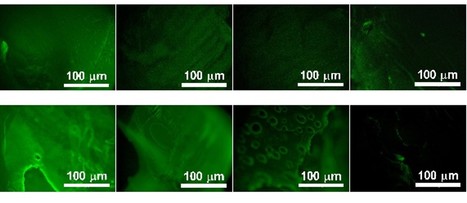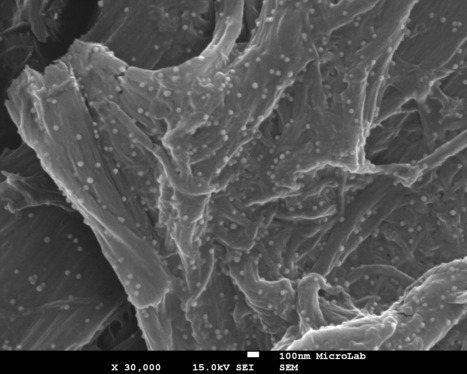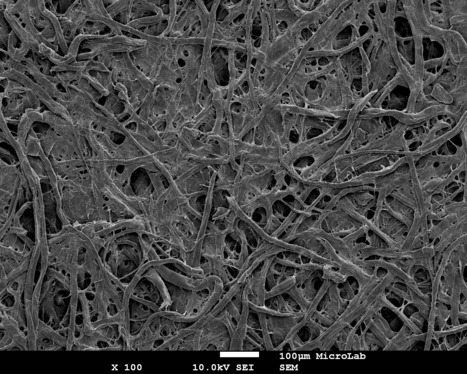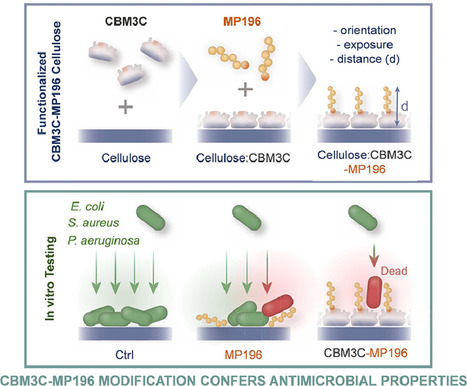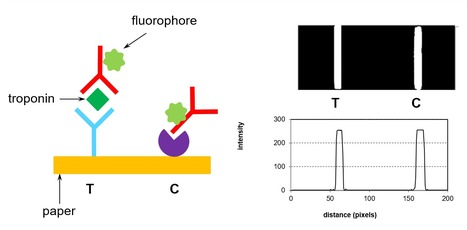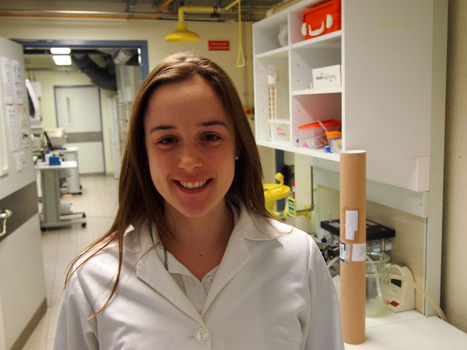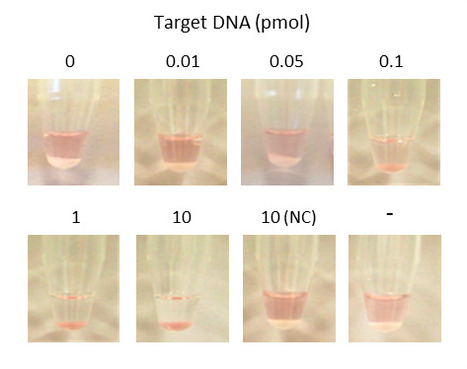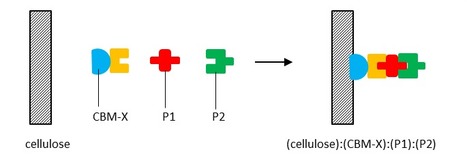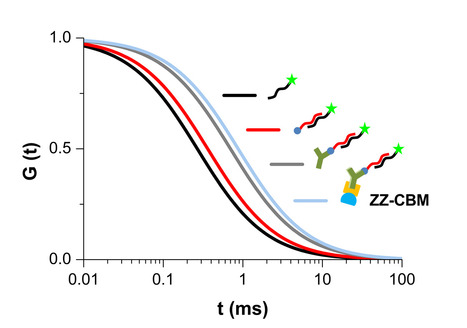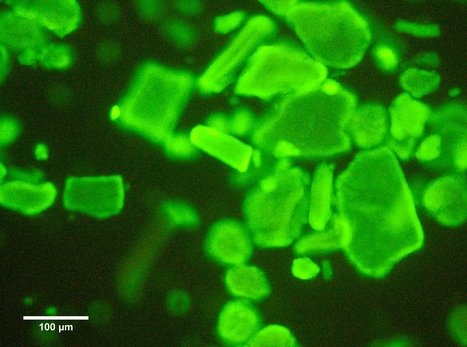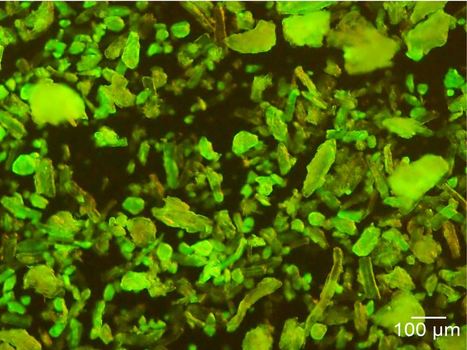 Your new post is loading...
 Your new post is loading...

|
Scooped by
iBB
April 1, 2022 6:51 AM
|
Cellulose-based LFA for Detection of Cystatin C
The relevance and impact of Lateral Flow Assays (LFA) as point-of-care devices has been amply demonstrated with the current SARS-CoV-2 pandemic. However, and despite their usefulness, drawbacks like low sensitivity, low specificity, and lack of quantitation are often associated with LFAs. In a paper published in Scientific Reports, Miguel Prazeres from BERG-IST and colleagues from the Indian Institute of Technology (Madras) propose a new LFA architecture that combines nitrocellulose strips with layered cellulose, ZZ-CBM3 fusions and fluorescently labeled Fab fragments. The system was successfully applied to the the quantitative, fluorescence-based detection of the kidney biomarker cystatin C. The work was funded by project CBM-X.

|
Scooped by
iBB
June 9, 2021 6:07 AM
|
Functionalization of Cellulose Hydrogels with Carbohydrate-Binding Module Fusions
Materials with novel and enhanced functionalities can be obtained by modifying cellulose with a range of biomolecules. In a recent paper published in Materials, Mariana Barbosa, Hélvio Simões and Miguel Prazeres from BERG-iBB describe the modification of cellulose hydrogels using bi-functional biomolecular constructs based on carbohydrate binding modules (CBMs). The binding of CBM fusions, the capture of antibodies and the grafting of oligonucleotides onto hydrogels was successfully demonstrated. The CBM-based platform could contribute significantly to the development of advanced medical diagnostic sensors or specialized biomaterials, among others. The work was funded by project CBM-X.

|
Scooped by
iBB
March 11, 2020 10:14 AM
|
Hélvio Simões Joins CBM-X Team as Junior Researcher
Hélvio Simões has joined the team of the FCT-funded project "CBM-X: Biorecognition as a Tool for the Functionalization of Cellulose-based Materials with Biomolecules and Nanostructures". During the next year, Hélvio will focus on the development of bi-functional biomolecular constructs combining Carbohydrate Binding Modules (CBMs) and oligonucleotide strands for nucleic acid detection.

|
Scooped by
iBB
August 3, 2019 5:52 AM
|
Back Cover of Biotechnology Journal Highlights iBB's Work on Functionalization of Cellulose-based Materials
BERG-iBB researchers led by Miguel Prazeres are developing biomolecular constructs for the precise modification of cellulose matrices with nanostructures and/or biomolecules. The back cover image of the August issue of Biotechnology Journal highlights a recent contribution of the group. The work is part of the FCT-funded project CBM-X.

|
Scooped by
iBB
April 17, 2019 5:07 AM
|
Mariana Barbosa Joins CBM-X Team as Research Scientist
Mariana Barbosa has joined the team of the FCT-funded project "CBM-X: Biorecognition as a Tool for the Functionalization of Cellulose-based Materials with Biomolecules and Nanostructures". During the next three years Mariana will be responsible for the development of bi-functional biomolecular constructs combining Carbohydrate Binding Modules (CBMs) with valuable biological partners that allow the modification of cellulose with nanomaterials or biomolecules in a controlled way. The project is a joint collaboration between BERG-iBB (Miguel Prazeres) and the portuguese company NZYTech.

|
Scooped by
iBB
June 7, 2018 6:45 AM
|
Biomolecular Constructs for Cellulose Modification
The project "CBM-X: Biorecognition as a Tool for the Functionalization of Cellulose-based Materials with Biomolecules and Nanostructures" has been recommended for funding by FCT (2017 Call for SR&TD Project Grants). The goal of CBM-X is to develop biomolecular constructs for the precise modification of cellulose matrices with nanostructures and/or biomolecules, and for the anchoring of nanocellulose onto a range of materials. The project, which falls within the scientific area of Materials Engineering, is headed by Miguel Prazeres from BERG-iBB and involves a collaboration with the company NZYTech.

|
Scooped by
iBB
April 18, 2017 1:23 PM
|
Materials with new and improved functionalities can be obtained by modifying cellulose with gold nanoparticles (AuNPs). In a paper published in the Journal of Molecular Recognition, António Almeida, Ana Rosa, Ana Azevedo and Miguel Prazeres from BERG-iBB, describe a method to functionalize cellulose with AuNPs that relies on 2 recognition elements: a ZZ-CBM3 fusion that combines a carbohydrate-binding module with the ZZ fragment of protein A and an anti-biotin antibody. Paper and cellulose microparticles with AuNPs immobilized via the ZZ-CBM3:anti-biotin IgG supramolecular complex displayed an intense red color, whereas no color is detected when AuNPs are deposited over the unmodified materials. The method also opens up the way for the development of simple and straightforward paper/cellulose-based tests where detection of a target analyte can be made by direct use of color signaling. Click on title to learn more.

|
Scooped by
iBB
November 11, 2016 9:25 AM
|
Description: Microscopic structure of chromatographic paper (100 Xs), featured photo by Ana Rosa and Miguel Prazeres, Copyright BERG-iBB 2016.
Context: BERG researchers led by Miguel Prazeres are developing paper-based biosensors for molecular diagnostics by combining affinity-based anchoring of biomolecules with nanoparticle-based detection. The work is being performed in the context of iBB’s Strategic Area 2: Advanced Bioprocess Engineering.
|

|
Scooped by
iBB
March 8, 2022 1:19 PM
|
A CBM-Hexapeptide Fusion Confers Antimicrobial Properties to Cellulose
A new strategy to modify cellulose with the short antimicrobial hexapeptide MP196 (RWRWRW-NH2) is proposed by BERG and BSIRG researchers that uses fusions of Cys-terminated derivatives of MP196 and a carbohydrate binding module (CBM). CBM3-MP196-modified cellulose hydrogels displayed antibacterial activity that was significantly higher when compared with controls. This versatile concept offers a toolbox for the functionalization of different cellulose materials with a broad choice in peptides. the paper was published in Acta Biomaterialia. The work was funded by project CBM-X.

|
Scooped by
iBB
February 14, 2021 7:15 AM
|
Cellulose-Based Lateral Flow Immunoassay for the Fluorescent Detection of Troponin
Lateral flow assays (LFA) are the dominant segment in the Point-Of-Care testing market. Analytical strips made of nitrocellulose (NC) are the heart of a LFA. However, NC is not necessarily the best matrix due to the inability to control the orientation of proteins, inconsistencies in flow rates, lot-to-lot variability, flammable nature, sensitivity to humidity, and an inherent brittleness. In a paper published in Biosensors, Miguel Prazeres from BERG-iBB with colleagues from the Indian Institute of Technology show that cellulose paper possesses the adequate characteristics to replace NC in a LFA for the quantitative, fluorescence-based detection of cardiac troponin I. It is further shown that the layering of carbon nanofibers favor the generation of more intense immunofluorescence signals. The results open up the possibility for companies to develop specialized cellulose strips for LFA. The work was funded by project CBM-X.

|
Scooped by
iBB
January 10, 2020 12:40 PM
|
Ana Margarida Rosa to Defend PhD Thesis in Biotechnology and Biosciences
Ana Margarida Rosa will be defending her PhD thesis in Biotechnology and Biosciences on Wednesday the 29th january 2020 (10:30 H, amphitheater PA-3, Mathematics Building). During the last years, and under the supervision of Miguel Prazeres from BERG-iBB and Pedro Paulo from CQE-IST, Ana developed a cellulose-based system for the colorimetric detection of nucleic acids by exploring the recognition of biotin-labeled DNA hybrids by anti-biotin antibodies immobilized through ZZ-CBM chimeric proteins. These fusions combine carbohydrate-binding modules (CBM) with affinity to cellulose and double Z domains (ZZ) that bind to IgG antibodies. The title of the thesis is “DNA recognition system on bioactive paper using fusions of carbohydrate-binding modules and IgG-binding Z domains”.

|
Scooped by
iBB
May 31, 2019 11:49 AM
|
Detection of DNA on Cellulose Microparticles Using ZZ-CBM Fusions and Gold Nanoparticles
Nucleic acid testing requires skilled personnel and expensive instrumentation and are thus difficult to implement in low income settings. In a paper published in the Biotechnology Journal, researchers from BERG-iBB describe a method for the detection of oligonucleotides that combines cellulose microparticles with biomolecular recognition. Cellulose microparticles are made bioactive by anchoring anti-biotin antibodies via ZZ-CBM fusions that combine a carbohydrate binding module with the ZZ fragment of protein A. Samples are prepared by incubating DNA probes immobilized on gold nanoparticles (AuNP) with biotin-labeled targets and then mixed with bioactive microparticles. The presence of un-labelled targets could also be probed by introducing a second, biotinylated DNA probe. The target:probe-AuNP hybrids are mixed with and captured by the microparticles, which change color from white to red. With this methodology, diverse analytical applications can be envisaged based on “reader-free” testing. The work was performed in the context of the project CBM-X.

|
Scooped by
iBB
November 23, 2018 5:17 AM
|
Research Scientist Position in Biomolecular Engineering is Open
A position is open at iBB to hire a doctorate researcher under the scope of the FCT-funded CBM-X project. The selected candidate (PhD holder) will work on the development (design, cloning, production, purification and testing) of bi-functional biomolecular constructs combining Carbohydrate Binding Modules (CBMs) with relevant biological partners (oligonucleotides, material binding peptides, avidin monomers and PDZ domains) that allow the modification of cellulose with nano materials and/or biomolecules.The work will be performed at BERG-iBB under the supervision of Prof. Miguel Prazeres. More information on the position and how to apply can be found here under the acronym CBM-X. The application deadline is February 5th, 2019.

|
Scooped by
iBB
June 7, 2017 6:15 AM
|
Protein:DNA supramolecular complexes are at the heart of many molecular diagnostic systems. In a paper just published in Physical Chemistry Chemical Physics, Ana Rosa and Miguel Prazeres from BERG-iBB and Pedro Paulo from CQE present a fluorescence correlation spectroscopy (FCS) study of the complexation of oligonucleotides, antibodies and a chimeric protein of IgG-binding ZZ domains fused with a carbohydrate binding module. The FCS-derived information obtained (diffusion coefficients, association constants, nanometer-scale size of complexes) is useful to gain insight into molecular interactions involved in diagnostic assays. Click on title to learn more.

|
Scooped by
iBB
February 10, 2017 2:14 PM
|
Type A Carbohydrate-Binding Modules (CBMs) are a critical component of cellulose-degrading microbial enzymes, but their mechanism of action remains poorly understood. In a paper just published in the Journal of Biological Chemistry, Miguel Prazeres and Pedro Pereira from BERG-iBB, working with researchers from the Faculty of Veterinary Medicine, Nova University and NZYTech describe the production and characterization of a library of recombinant CBMs representative of the known diversity of type A modules. The binding properties of 40 CBMs, in fusion with an N-terminal green fluorescence protein (GFP) domain, revealed that type A CBMs possess the ability to recognize different crystalline forms of cellulose and chitin over a wide range of temperatures, pHs and ionic strengths. A Spirochaeta thermophila CBM64, in particular, displayed plasticity in its capacity to bind both crystalline and soluble carbohydrates under a wide range of extreme conditions. The structure of S. thermophila StCBM64C was further solved, revealing an untwisted, flat, carbohydrate-binding interface comprising the side chains of four tryptophan residues in a coplanar linear arrangement. Click on title to learn more.

|
Scooped by
iBB
May 6, 2016 4:09 PM
|
Fluorescence microscopy photography of carbohydrate binding module-green fluorescent protein (CBM3-GFP) fusions bound to cellulose 20 micron-sized microparticles. The CBM3 is from C. thermocellum. This work was developed as a partnership between a team of BERG-iBB researchers led by Miguel Prazeres and the company NZYTech. The project was funded by Programa Operacional Regional de Lisboa, FEDER (project n.º 30270 - “CBM sensor paper”)
|
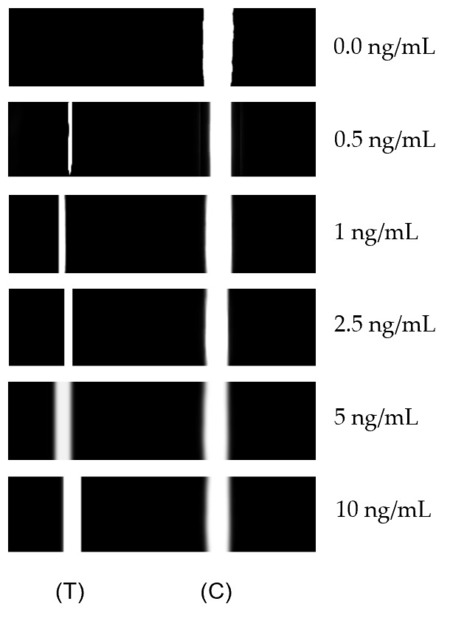



 Your new post is loading...
Your new post is loading...


